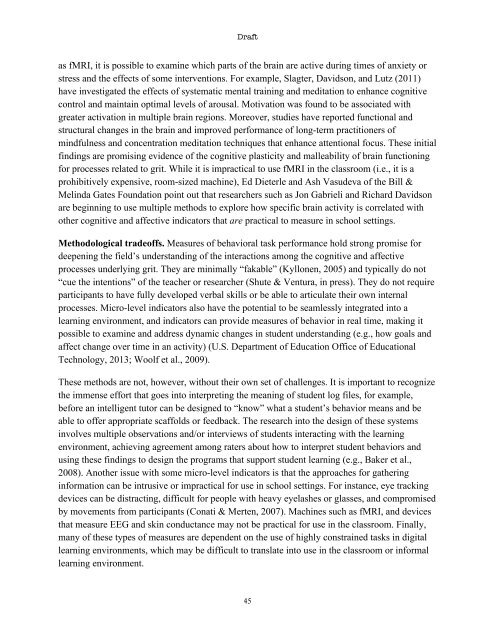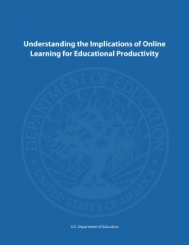Promoting Grit, Tenacity, and Perseverance - U.S. Department of ...
Promoting Grit, Tenacity, and Perseverance - U.S. Department of ...
Promoting Grit, Tenacity, and Perseverance - U.S. Department of ...
Create successful ePaper yourself
Turn your PDF publications into a flip-book with our unique Google optimized e-Paper software.
Draft<br />
as fMRI, it is possible to examine which parts <strong>of</strong> the brain are active during times <strong>of</strong> anxiety or<br />
stress <strong>and</strong> the effects <strong>of</strong> some interventions. For example, Slagter, Davidson, <strong>and</strong> Lutz (2011)<br />
have investigated the effects <strong>of</strong> systematic mental training <strong>and</strong> meditation to enhance cognitive<br />
control <strong>and</strong> maintain optimal levels <strong>of</strong> arousal. Motivation was found to be associated with<br />
greater activation in multiple brain regions. Moreover, studies have reported functional <strong>and</strong><br />
structural changes in the brain <strong>and</strong> improved performance <strong>of</strong> long-term practitioners <strong>of</strong><br />
mindfulness <strong>and</strong> concentration meditation techniques that enhance attentional focus. These initial<br />
findings are promising evidence <strong>of</strong> the cognitive plasticity <strong>and</strong> malleability <strong>of</strong> brain functioning<br />
for processes related to grit. While it is impractical to use fMRI in the classroom (i.e., it is a<br />
prohibitively expensive, room-sized machine), Ed Dieterle <strong>and</strong> Ash Vasudeva <strong>of</strong> the Bill &<br />
Melinda Gates Foundation point out that researchers such as Jon Gabrieli <strong>and</strong> Richard Davidson<br />
are beginning to use multiple methods to explore how specific brain activity is correlated with<br />
other cognitive <strong>and</strong> affective indicators that are practical to measure in school settings.<br />
Methodological trade<strong>of</strong>fs. Measures <strong>of</strong> behavioral task performance hold strong promise for<br />
deepening the field’s underst<strong>and</strong>ing <strong>of</strong> the interactions among the cognitive <strong>and</strong> affective<br />
processes underlying grit. They are minimally “fakable” (Kyllonen, 2005) <strong>and</strong> typically do not<br />
“cue the intentions” <strong>of</strong> the teacher or researcher (Shute & Ventura, in press). They do not require<br />
participants to have fully developed verbal skills or be able to articulate their own internal<br />
processes. Micro-level indicators also have the potential to be seamlessly integrated into a<br />
learning environment, <strong>and</strong> indicators can provide measures <strong>of</strong> behavior in real time, making it<br />
possible to examine <strong>and</strong> address dynamic changes in student underst<strong>and</strong>ing (e.g., how goals <strong>and</strong><br />
affect change over time in an activity) (U.S. <strong>Department</strong> <strong>of</strong> Education Office <strong>of</strong> Educational<br />
Technology, 2013; Woolf et al., 2009).<br />
These methods are not, however, without their own set <strong>of</strong> challenges. It is important to recognize<br />
the immense effort that goes into interpreting the meaning <strong>of</strong> student log files, for example,<br />
before an intelligent tutor can be designed to “know” what a student’s behavior means <strong>and</strong> be<br />
able to <strong>of</strong>fer appropriate scaffolds or feedback. The research into the design <strong>of</strong> these systems<br />
involves multiple observations <strong>and</strong>/or interviews <strong>of</strong> students interacting with the learning<br />
environment, achieving agreement among raters about how to interpret student behaviors <strong>and</strong><br />
using these findings to design the programs that support student learning (e.g., Baker et al.,<br />
2008). Another issue with some micro-level indicators is that the approaches for gathering<br />
information can be intrusive or impractical for use in school settings. For instance, eye tracking<br />
devices can be distracting, difficult for people with heavy eyelashes or glasses, <strong>and</strong> compromised<br />
by movements from participants (Conati & Merten, 2007). Machines such as fMRI, <strong>and</strong> devices<br />
that measure EEG <strong>and</strong> skin conductance may not be practical for use in the classroom. Finally,<br />
many <strong>of</strong> these types <strong>of</strong> measures are dependent on the use <strong>of</strong> highly constrained tasks in digital<br />
learning environments, which may be difficult to translate into use in the classroom or informal<br />
learning environment.<br />
45
















